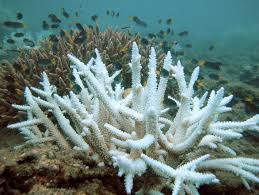UN Climate Change News, 6 July 2018 – Climate Change is set to make UNESCO World Heritage coral reefs disappear by 2100 unless greenhouse gas emissions are reduced in line with the goals of the Paris Agreement on climate action, according to a UN study.
The social, cultural and economic value of coral reefs is estimated at US$1 trillion, and unless CO2 emissions are drastically reduced, they will continue to be decimated at unprecedented rates, and will ultimately vanish.
It only takes a spike of 1-2°C to cause bleaching, and carbon emissions have already caused a 1°C increase in global surface temperature since pre-industrial times. This effect has been magnified by strong El Niño and La Niña events. Ocean acidification caused by dissolved atmospheric CO2 weakens corals further.
“The 29 globally significant coral reefs on UNESCO’s World Heritage List are facing existential threats, and their loss would be devastating ecologically and economically,” said Dr. Mechtild Rossler, Director of the World Heritage Centre. “These rainforests of the sea protect coastal communities from flooding and erosion, sustain fishing and tourism businesses, and host a stunning array of marine life.”
Recent projections also indicate that climate-related loss of reef ecosystem services will total US$500 billion per year or more by 2100, with the greatest impacts felt by people who rely on reefs for day-to-day subsistence. Moreover, despite covering less than 0.1% of the ocean floor, reefs host more than one quarter of all marine fish species, in addition to many other marine animals.
The affected sites include the Great Barrier Reef (Australia), Papahānaumokuākea (USA), the Lagoons of New Caledonia (France) and Aldabra Atoll (Seychelles).
When climate change causes water temperature to rise, corals undergo bleaching as a stress response by expelling the algae (zooxanthellae) living in their tissues. This process turns the coral completely white. Bleached corals are still alive – however, even mild bleaching can result in subsequent deleterious effects, such as reduced growth and reproduction. If stressful conditions persist for several weeks, corals may die from a lack of food or from disease. Coral mortality and subsequent erosion of their skeletons reduce the structural complexity and biodiversity of the reef system.
Widespread coral bleaching was first documented in 1983, but the frequency and severity is increasing. The last three years were the hottest on record, and they caused a global bleaching event that reached 72% of World Heritage-listed reefs.
“We know the frequency and intensity of coral bleaching events will continue to increase as temperatures rise,” said Dr. Scott Heron, NOAA Coral Reef Watch and lead author of the assessment. “Our goal was to document climate impacts on World Heritage-listed coral reefs to date, and examine what the future may hold. The fate of these treasures matters to all humankind, and nations around the world are bound by the 1972 World Heritage Convention to support their survival.”
Coral communities typically take 15 to 25 years to recover from mass bleaching. The assessment looked at the frequency with which World Heritage reefs have been subjected to stress that exceeds best-case rates of recovery. The assessment was developed with satellite data from the United States National Ocean and Atmospheric Administration’s (NOAA) Coral Reef Watch and received the support from the French Agency for Biodiversity (Agence Française pour la Biodiversité).
